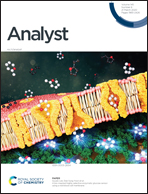A sensitive “ON–OFF” fluorescent probe based on carbon dots for Fe2+ detection and cell imaging†
Abstract
Fe2+ is a trace metal ion required by the human body, and its abnormal metabolism can cause serious diseases. Herein, we report the development of a highly efficient “ON–OFF” fluorescent probe based on carbon dots (CDs), prepared by a simple one-step hydrothermal method. The CDs exhibited exceptional water dispersibility and stability, superior luminescence performance and low cytotoxicity. The fluorescence could be efficiently quenched by Fe2+ through an electronic transfer process. And under the optimized experimental conditions, this probe shows excellent selectivity and high sensitivity towards Fe2+ with a detection limit of 51 nmol. More interestingly, this probe could realize the visual detection of Fe2+ when Fe3+ and Cu2+ ions were efficiently shielded by tartaric acid in the presence of ascorbic acid. Furthermore, the developed fluorescent probe has been successfully applied for the detection of Fe2+ in tap water and BSA solution as well as for the biosensing of Fe2+ in living cells.



 Please wait while we load your content...
Please wait while we load your content...